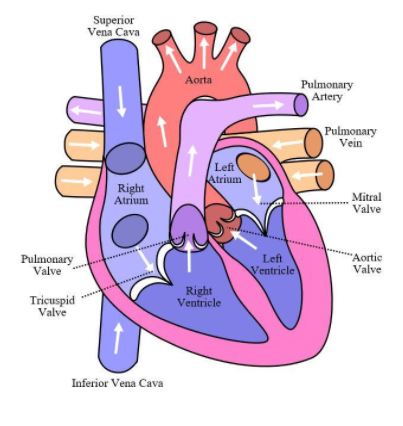
What is the function of valves present in the heart?
Answer
475.8k+ views
Hint: Valves are one-way that allows the blood flow (movement of blood through vessels from arteries to capillaries then into the veins) to flow in one direction throughout the heart. These heart valves are classified into four types which are responsible for blood flow pathway in the heart.
Complete answer:
Heart valves are the flap-like structure that normally allows blood to flow in one direction throughout the heart. There are four-valves commonly represented in the mammalian heart that determines the pathway for the flow of blood through the heart. The heart valve opens and closes depending on differential blood pressure on each side. Four valves of the heart are the Atrioventricular valve, Mitral valve, pulmonary valve, and Tricuspid valve:
Atrioventricular valve (pumps blood from the left ventricle to aorta), the mitral valve (pumps blood from left atrium to the left ventricle), and the tricuspid valve (pumps blood from atrium to the right ventricle) are present between the upper and the lower chambers of the heart. The upper chamber of the heart is atria whereas the lower chamber of the heart is ventricles.
The semilunar valves which are present in the arteries and help in the blood flow are of two types i.e. the aortic valve, and the pulmonary valve. On the right side of the heart tricuspid valve and the pulmonary valve are present whereas on the left side of the heart mitral valve and the aortic valve are present.
Heart valves are covered by the protective layer or covering known as the endocardium which separates the arteries and the veins through the blood vessels. These valves are situated around the fibrous rings of the cardiac skeleton. The function of the two atrioventricular valves is to prevent the backflow of the blood into the atria while the two semilunar valves prevent the blood backflow into the ventricles.

Note: These heart valves help in the regulation of blood flow in the right direction with the right rate. Before leaving the heart chamber blood passes through these valves.
Complete answer:
Heart valves are the flap-like structure that normally allows blood to flow in one direction throughout the heart. There are four-valves commonly represented in the mammalian heart that determines the pathway for the flow of blood through the heart. The heart valve opens and closes depending on differential blood pressure on each side. Four valves of the heart are the Atrioventricular valve, Mitral valve, pulmonary valve, and Tricuspid valve:
Atrioventricular valve (pumps blood from the left ventricle to aorta), the mitral valve (pumps blood from left atrium to the left ventricle), and the tricuspid valve (pumps blood from atrium to the right ventricle) are present between the upper and the lower chambers of the heart. The upper chamber of the heart is atria whereas the lower chamber of the heart is ventricles.
The semilunar valves which are present in the arteries and help in the blood flow are of two types i.e. the aortic valve, and the pulmonary valve. On the right side of the heart tricuspid valve and the pulmonary valve are present whereas on the left side of the heart mitral valve and the aortic valve are present.
Heart valves are covered by the protective layer or covering known as the endocardium which separates the arteries and the veins through the blood vessels. These valves are situated around the fibrous rings of the cardiac skeleton. The function of the two atrioventricular valves is to prevent the backflow of the blood into the atria while the two semilunar valves prevent the blood backflow into the ventricles.

Note: These heart valves help in the regulation of blood flow in the right direction with the right rate. Before leaving the heart chamber blood passes through these valves.
Recently Updated Pages
Master Class 11 Economics: Engaging Questions & Answers for Success

Master Class 11 Business Studies: Engaging Questions & Answers for Success

Master Class 11 Accountancy: Engaging Questions & Answers for Success

Master Class 11 English: Engaging Questions & Answers for Success

Master Class 11 Computer Science: Engaging Questions & Answers for Success

Master Class 11 Maths: Engaging Questions & Answers for Success

Trending doubts
State and prove Bernoullis theorem class 11 physics CBSE

1 ton equals to A 100 kg B 1000 kg C 10 kg D 10000 class 11 physics CBSE

State the laws of reflection of light

One Metric ton is equal to kg A 10000 B 1000 C 100 class 11 physics CBSE

1 Quintal is equal to a 110 kg b 10 kg c 100kg d 1000 class 11 physics CBSE

Difference Between Prokaryotic Cells and Eukaryotic Cells




